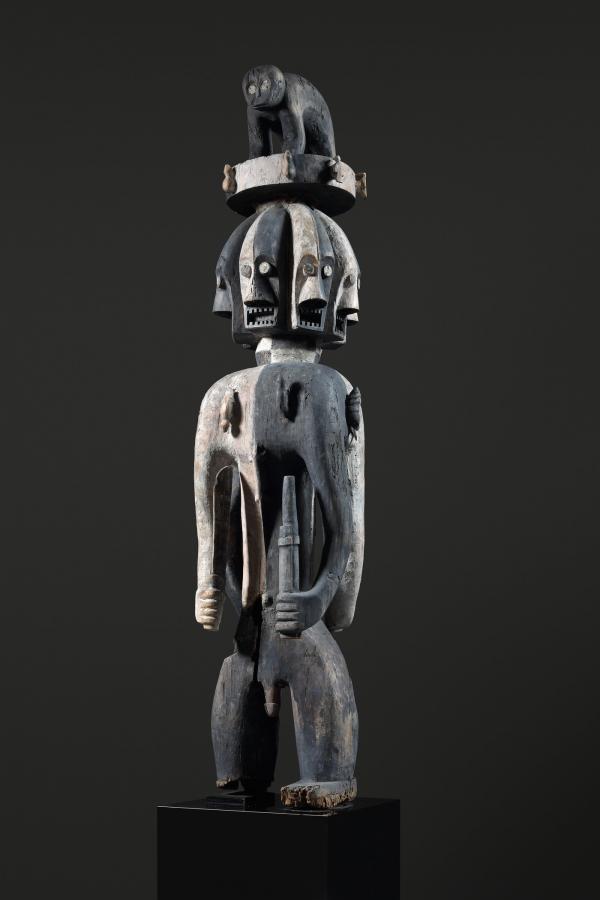This commanding sculpture is among the most remarkable works of sub-Saharan Africa. It is the most imposing and expressive of all known examples. No other Ijo forest spirit figure has this sculpture’s presence and abstract rendering. Its size and artistic virtuosity place it not only at the apex of its corpus, but also at the height of African artistic expression.
The monumentality of this awe-inspiring figure with seven heads and 14 eyes is emblematic of its role in safeguarding a community and promoting well-being. Ijo peoples reside amid the many estuaries and mangrove forests of the vast Niger Delta. They associate waterways with commerce and wealth, whereas forests are fraught with danger from natural enemies and existential perils. In this environment of extremes, benevolent water spirits manifest through masquerades of marine imagery, while fierce and volatile forest spirits dwell in protective shrine figures whose multiple heads and eyes facilitate all-seeing powers.
The figure is composed of two male figures, back-to-back and divided down the center of their torsos with black and white pigment. They bear weapons and prestige emblems: cutlass, rifle, spear, and stout cudgel. The figures’ broad shoulders, massive thighs, and ready stances bespeak alert, superhuman vigilance, amplified by medicinal amulets upon their chests that render them impervious to enemies and capable of otherworldly triumphs. A leopard stands on a platform upon the heads as the ultimate force of might and majesty.
The work’s seven faces present alternating fields of black and white to produce a geometry that refracts and multiplies. Fourteen piercing eyes express a fearsomely assertive panoptic gaze, for nothing escapes the spirit’s attention. Bared teeth suggest that great warriors possess both magical knowledge and magical speech that enable those so empowered to become invisible to enemies while overpowering in utterance.
Forest spirit figures secured the thresholds to Ijo settlements from human and supernatural intruders through their invincible agency and protective fortitude. A theme of one in many emerges, for Ijo are an egalitarian society that values valor through individual accomplishment matched by solidarity. The sculpture presents just such collectivity, and may allude to an antagonistic seven-headed hero from Ijo oral literature named Tebesonoma, the “indefatigable fighter”: “tall like a tree he stood,” but as a forest he prevailed.
This Ijo forest spirit was the centerpiece of the 2008 LACMA exhibition Tradition as Innovation in African Art. With a view from every vantage point, the work will have prominence and purpose in LACMA’s permanent collection galleries, assuring and underscoring the multiplicity of visions and perspectives that LACMA embodies and imparts. It will celebrate the integrity of African arts for posterity, as well as the ineffable power of the arts to express extraordinary forces of the universe.
During our 32nd annual Collectors Committee Weekend (April 20–21), members of LACMA's Collectors Committee generously helped the museum acquire 10 works of art spanning a breadth of eras and cultures. Check back tomorrow to learn about another acquisition.



